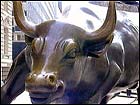|
The bulls begin to gather
|
 |
October 23, 2001: 4:41 p.m. ET
They're not exactly running, but conditions seem ripe for a stampede.
By Staff Writer Mark Gongloff
|
NEW YORK (CNNmoney) - At first glance, this couldn't be a more improbable time for a bull market to be gathering steam.
The United States is in the first stage of what promises to be a long campaign against global terrorism. Two postal workers died this week of inhalation anthrax, and dozens more have been exposed to the bacteria. Corporate profit warnings for the third quarter have nearly doubled the number a year ago.
But the Dow Jones industrial average, after suffering its worst weekly percentage loss since the Great Depression in the first week of trading following the Sept. 11 terror attacks, has roared back to pre-attack levels and beyond, gaining 13 percent since the valley it hit on Sept. 23.
And Monday's stunning rally, in which both the Dow and the Nasdaq grew about two percent on the day despite the news of the anthrax deaths and falling economic indicators, had many observers talking about the possibility of a bull run.
"There's an old adage on Wall Street: bull markets climb a wall of worry," Hugh Johnson, chief investment officer at First Albany, told CNNmoney Morning Tuesday. "Needless to say, there are a lot of worries out there."
But is the rally of the past few weeks a dead-cat bounce, luring hapless investors back to the market too early, or the beginning of a sustainable rally?
Looking to 2002
Stocks are rising, most observers say, because markets are looking past the immediate uncertainties and focusing on a likely recovery early next year from a long slowdown - probably a recession - in the U.S. economy and a corresponding slump in corporate profits.
"The equity market typically positions itself for economic recovery at the approximate mid-point of recession," said Christine Callies, chief U.S. investment strategist at Merrill Lynch.
If the recession - commonly defined as two or more consecutive quarters of shrinking gross domestic product (GDP) growth - started in the third quarter, after the terror attacks, and continues into the first quarter of 2002, as some economists expect, then the mid-point would fall in the current fourth quarter.
But markets were a little shakier Tuesday, unable to shrug off more bad news - another possible case of inhalation anthrax identified in New Jersey - and mixed corporate earnings.
"You want to see the follow-on rally when you see an up day like (Monday) because that brings the bulls even further into the game," Barry Hyman, chief investment strategist at Ehrenkrantz King Nussbaum, told CNNfn's Market Call program.
Still, Monday's rally was a notable deviation from the market's normal behavior during a year-long bear market -- namely, to react to bad news by selling off.
"If the focus on the market were to continue to go up even with bad news, that would indicate to me we're going to recover," said Phil Dow, stock market strategist at Dain Rauscher Wessels.
For now, it's probably too early to call a bull market, but the stage is almost set for one, according to First Albany's Johnson. Aggressive interest-rate cuts by the Federal Reserve - nine this year, setting a target for short-term rates not seen since the Kennedy administration - have helped put enough money in people's pockets to spark purchases of stocks and goods, fueling markets and the economy at the same time.
In addition to rate cuts and liquidity, an improvement in leading economic indicators is the third element necessary for a bull market, Johnson said. Those fell in August and September, but an upturn could come soon, triggering a sustainable rally.
"If you get that configuration, particularly liquidity conditions, usually you can bet pretty heavily that this is going to be a bull market," Johnson said.
The government, through tax cuts and spending, could also help foster a bull run with a multi-billion dollar stimulus package, the details of which are being discussed by President Bush and Congress. They hope to boost consumer spending and, eventually, correct a long slowdown in business spending, which has hindered economic growth for more than a year.
Click here for CNNmoney.com's economic calendar
"My sense is that the market is responding to the possibility that a meaningful economic stimulus package will be in place soon that will at least shore up some of the shortfall in capital spending," said Alan Ackerman, market strategist at Fahnestock & Co.
In the meantime, investors will study the tea leaves of economic data and corporate earning reports, looking for signs of consistent strength. And, though it's hard to imagine, it's still possible that something as shocking as the Sept. 11 attacks could happen again. In that case, or if the United States suffers a military setback in Afghanistan or elsewhere, the recovery could be postponed.
"Right now, there are bulls, there are bears and there are plenty of bewildered," Ackerman said. "We're trying to get through a period of very complex cross-currents, and so far the market's done remarkably well." 
|
|
|
|
|
 |

|

